Njamito Goes Fairtrade for Cocoa and Vanilla
March 31, 2025Njamito is now Fairtrade certified for cocoa and vanilla! Here’s what that means for farmers, the planet, and the values behind our meal-in-a-bottle.
Read articleMulti-year crop rotation is key to creating a sustainable and thriving agricultural landscape, and one of our key priorities.
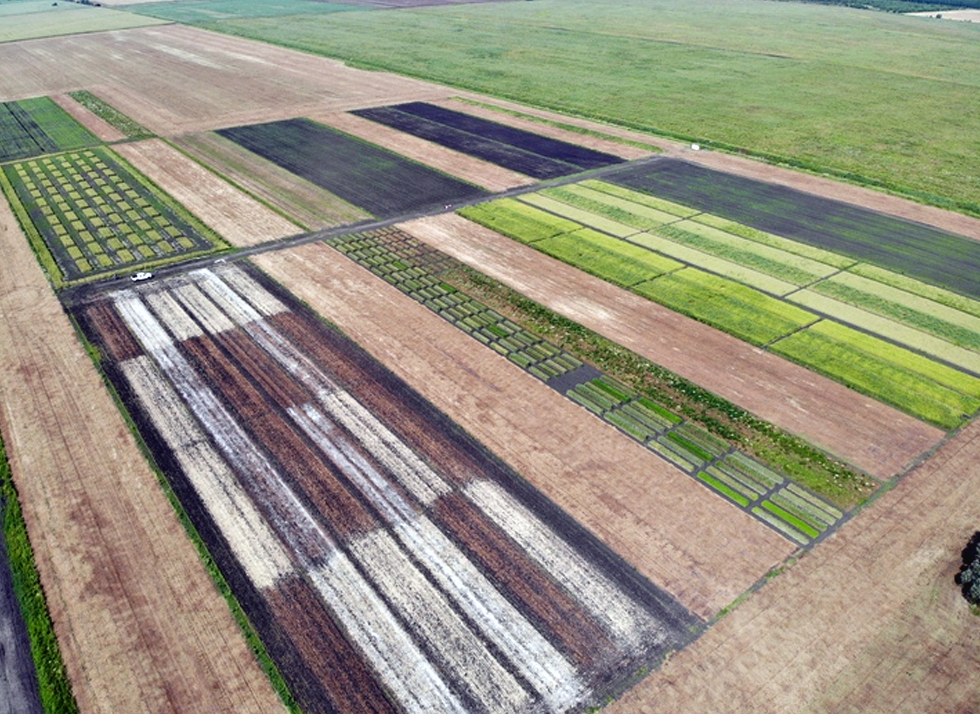
Just like any other sector or industry, agriculture has evolved over time. Some changes have led to more efficiency, while others have made food more accessible to an ever-growing population. However, these same changes have led us to the point where we are seriously damaging the environment, biodiversity, and our health. One such detrimental practice, over-specialization, could be replaced with an age-old sustainable practice that is crop rotation. Let’s look at what crop rotation is and why we need it.
Crop rotation, an age-old agricultural practice, involves the intentional sequencing of crops over defined periods and spaces to optimize soil health, manage pests and weeds effectively, and enhance overall agricultural efficiency.
Considering that crop rotation has been around for a significant amount of time in human history, its importance in sustainable farming practices cannot be underestimated.
However, the relentless pursuit of increased efficiency in agriculture, focusing on maximizing profit per unit area, has led to the emergence of specialization in production. And so, only the most profitable crops started being cultivated, leading to simplified crop rotation practices. Adding to this was the invention and widespread use of mineral fertilizers, synthetic pesticides and genetic modification of plants.
And so, in the industrial agriculture of today we are witness to a single cultivation technology, a standard set of agricultural machinery, and minimal changes in the organization of the process on farms.
While such an approach has enabled us to produce the most food in human history and helps us feed the ever growing global population, it also brought serious consequences for the environment. In fact, conventional agricultural practices mentioned above have contributed to the deterioration of our environment so much that according to FAO, 33% of the Earth’s soils are already degraded and over 90% could become degraded by 2050 if we don’t act. This would mean less and worse quality food for generations to come.
Growing the same crop on the same field over an extended period is known as monoculture. This approach has an extremely negative impact on the yield and quality of the given crop, overall biodiversity, and the health of the soil itself. That is because in monoculture, the plant’s root system absorbs nutrients from the same depth in the soil, in the same proportions, during the same time period. This can lead to an imbalance in soil nutrients as the same plant is constantly requiring the same nutrients at the same soil layer. Moreover, the root system’s exudates often act autotoxic, further complicating the situation. These factors together lead to a phenomenon known as soil fatigue.
Monoculture also provides ideal conditions for the development and spread of plant diseases and pests. That is because the development cycle of certain pests and diseases gets synchronized with a particular crop, so if we keep planting the same crop over and over again, the same pests and diseases will be coming back. Conventional agriculture fights this problem with synthetic pesticides. But there is a more sustainable way. Alternating various crops prevents a situation where a specific pest or disease develops and stays over an extended period of time.
The same applies to weeds. Each crop has its companions. In wheat, for example, weed companions are wild mustard, cleavers, and chickweed. The development cycle of these weeds perfectly aligns with the wheat cycle, and their seed bank in the soil is replenished every year. So, by constantly planting one crop type, we also continue having the same weeds. And they influence biodiversity of soil microorganisms, so having the same crops over and over, results in a reduced ability of the soil to mineralize organic matter, a decrease in the population of beneficial microorganisms, and an increase in the population of pathogenic microorganisms.
All these factors together contribute to a serious disruption of soil structure, leading to a reduction in the natural fertility of the soil.
This is why crop rotation is essential.
In some parts of the world, above described principles of industrial agriculture have been slightly adapted to respond to local environmental conditions. For example, in Serbia, specifically the region of Banat with a semi-arid climate and heavy clay soil, a very simple two-year crop rotation was developed alternating wheat, and sunflower. While it might seem that such an approach is a partial solution to environmental challenges, this two-year crop rotation still brings with it all the characteristics of monoculture, and all its consequences.
Within this two-year system, wheat production requires the application of a minimum of 170 kgN/ha from mineral fertilizers, while herbicides are used to control winter weeds. Over time, the number of synthetic pesticide treatments has increased to 6-8 times, with the more frequent use of growth regulators. In sunflowers, there is a noticeable increase in the area under so-called “chemical hybrids” that are resistant to herbicides, which conventional sunflowers cannot tolerate. In years with abundant rainfall during sunflower flowering, numerous diseases emerge, white mold, also known as Sclerotinia, being the most dangerous. On plants affected by this disease, a large number of sclerotia is formed. These structures are detrimental because they enable long-term vitality of the pathogen in the soil, which can last up to 10 years.
The most effective way to mitigate the negative consequences that monoculture and two-year crop rotations bring is simple: avoid frequent cultivation of the same crop on the same plot and rotate different crops over time and space, applying multi-year crop rotation strategies.
Therefore, we have taken it as our goal to understand how crop rotation works and what sequences will ensure sufficient nitrogen to achieve satisfactory yields, reduce overall weediness, control the number of pathogens in the plot, and encourage the accumulation of organic matter in the soil.
In developing our complex crop rotation system, we began with straightforward, reliable solutions that we could confidently expect to yield positive results. In organic, livestock-free farming, where purchasing fertilizers isn’t an option, nitrogen must be supplied exclusively through legumes – efficient symbiotic nitrogen fixers. Aligned with this approach, we initially adopted a three-year rotation of peas, cereal, and sunflower.
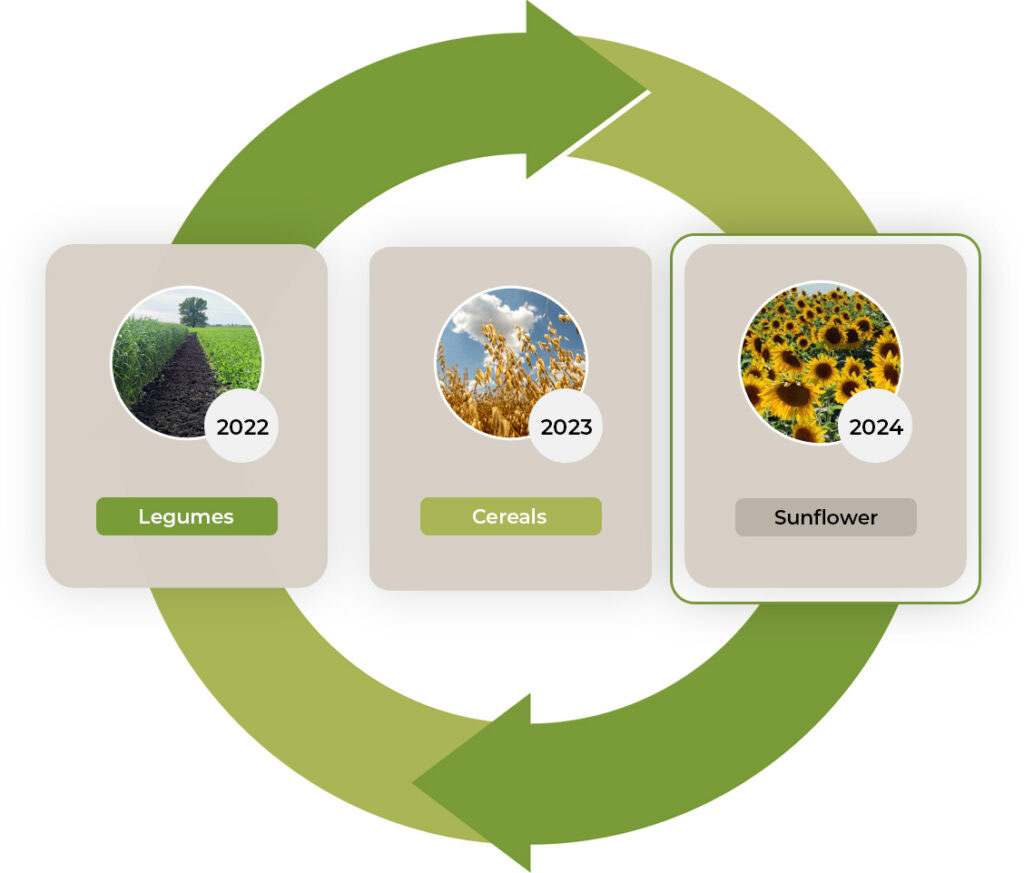
Each crop in this rotation played a strategic role:
1) Peas (a pulse from legume family): A primary, highly efficient nitrogen producer, providing a strong grain yield with high protein content.
2) Cereal: The main consumer of readily available nitrogen, significantly enhancing both yield and grain quality.
3) Sunflower: A spring scavenging crop with a deep, robust root system, chosen for its drought tolerance, nutrient retrieval efficiency, and ability to effectively disrupt the growth cycle of winter weeds.
This initial rotation established a solid foundation for nutrient balance, soil health, and weed management, creating a dependable starting point from which we could advance into more tailored and sophisticated crop rotation strategies.
To further enhance our approach to nitrogen management and disease control, we tested broad beans as an alternative to peas in the first position of our three-year rotation. Initial results have been promising: while broad beans share some common diseases with peas, they do not share all, allowing for better disease management across seasons.
Given that legumes had not been cultivated on our land for decades, we started with this three-year crop rotation to work toward an optimal solution. Recognizing that bringing legumes back to the same plot every three years could lead to issues like legume fatigue due to disease buildup, we expanded to a four-year rotation by adding another cereal. This adjustment increased the interval between legume plantings on each plot, reducing disease pressure and supporting the long-term sustainability of our crops.
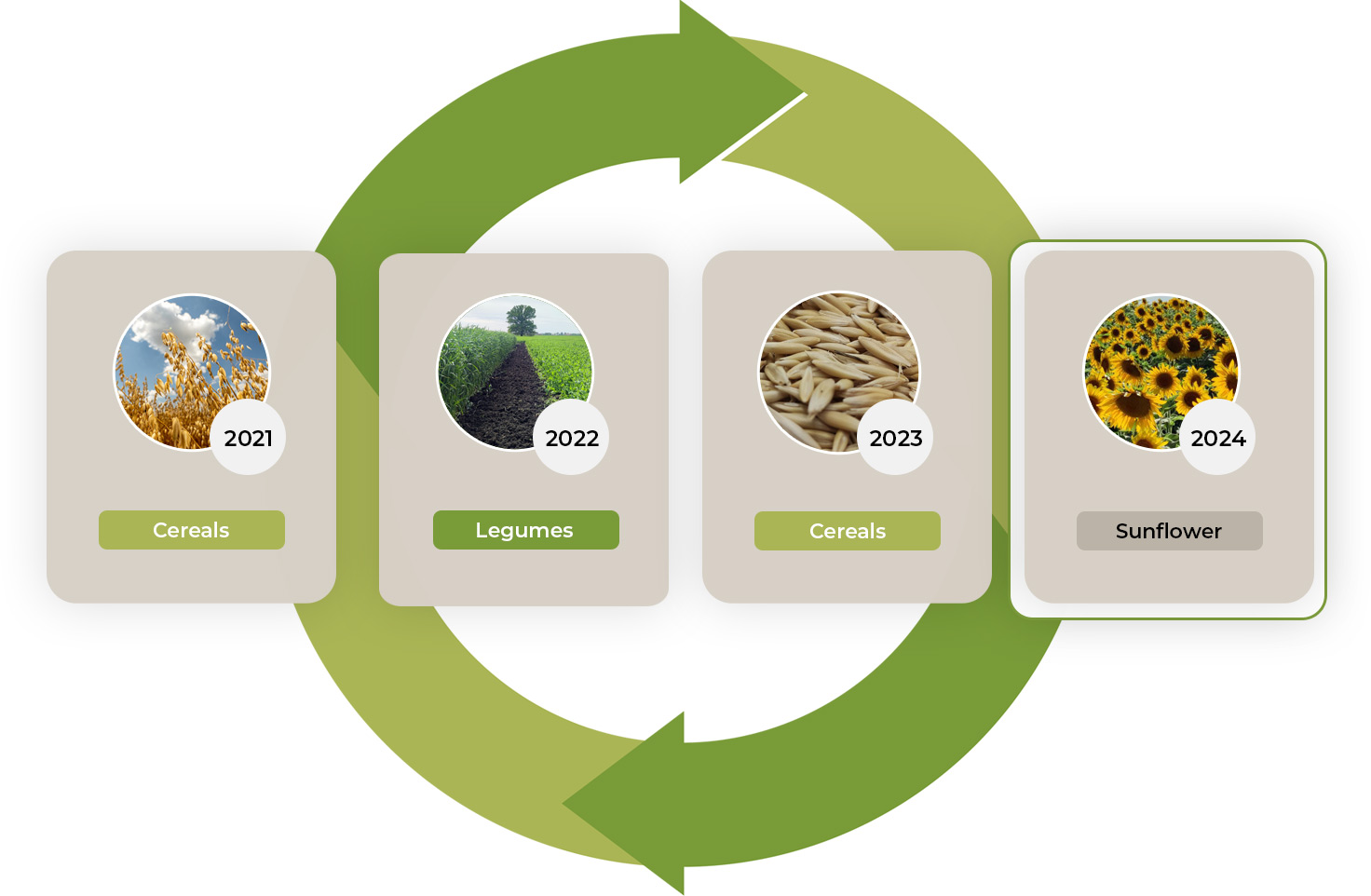
Although reintroducing a cereal this frequently isn’t ideal, we chose this approach as the most viable option given our specific conditions. Our semi-arid climate, while limiting productivity, naturally lowers the risk of fungal diseases in cereals due to its low humidity and reduced rainfall. These conditions allow for a more frequent cereal rotation without significantly increasing disease pressure, supporting a sustainable and balanced crop system.
During this period, in 2024, we decided to transition into a gluten-free farm, guided by two main goals:
This decision led us to discontinue the cultivation of wheat, barley, spelt, and rye, focusing instead on oats-primarily winter oats-as our main cereal crop.
Building on insights from extensive testing with over 50 crops and encouraged by the promising performance of chickpeas and winter flax, we have begun incorporating these resilient, high-value crops into our four-year rotation: peas-oats-flax(or chickpeas)-sunflower in fall 2024.
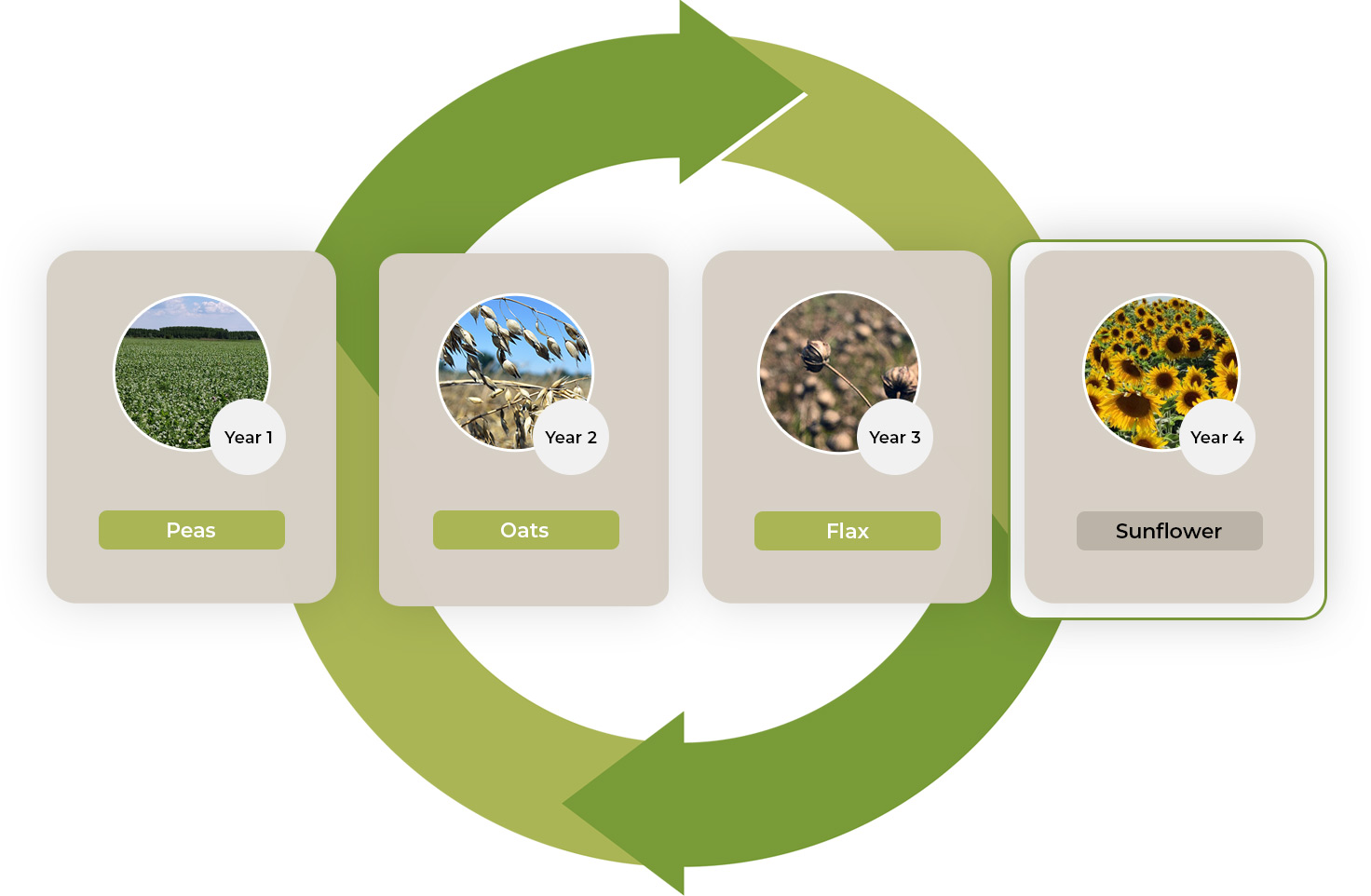
Flax plays a unique role in our rotation as a crop that removes only a modest amount of nitrogen due to its naturally low grain yield (1.5-1.7 t/ha), yet produces valuable, high-cost seeds.
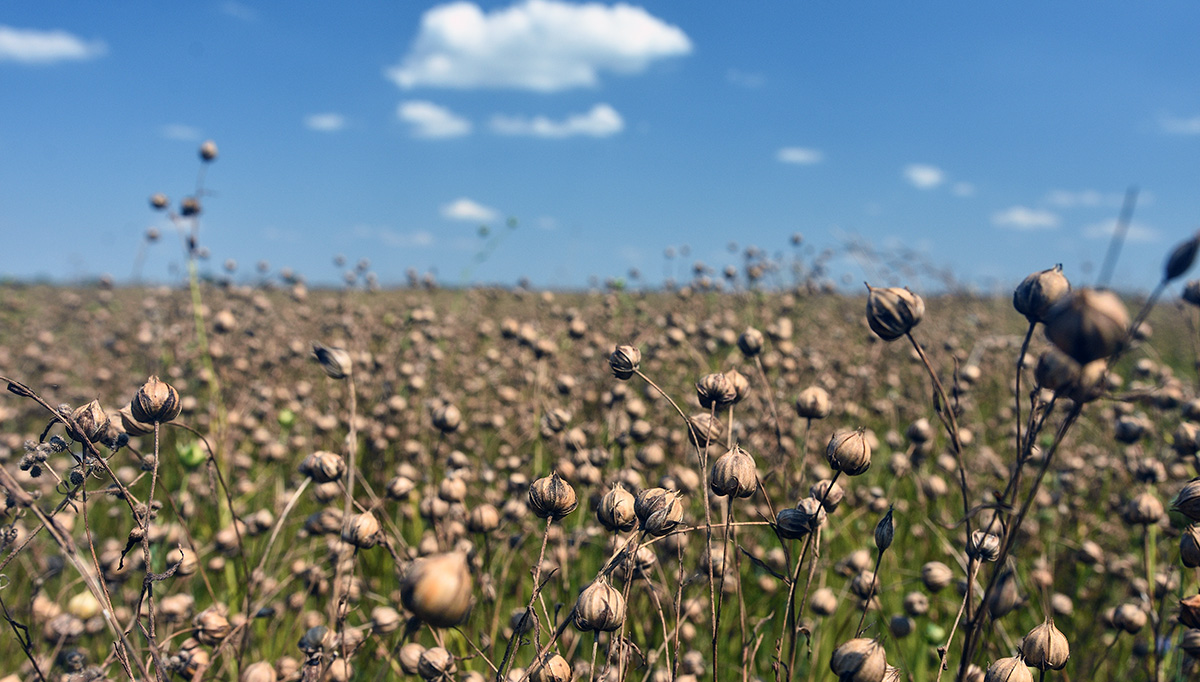
To highlight its ecological and economic sustainability, a yield of 1.7 t/ha of organic flax is equivalent in value to 7-9 t/ha of organic wheat, which requires 3.5 times more nitrogen than flax. Its low nitrogen removal makes flax an ideal fit within a nitrogen-limited system, while its abundant crop residues contribute substantial organic matter back to the soil. Additionally, flax demonstrates strong tolerance to diseases and pests under our conditions, requiring minimal to no intervention.
This dual function—yielding a premium product while enhancing soil organic content—positions flax as a strategic crop that supports soil health, economic sustainability, and resilience within our gluten-free rotation.
Chickpeas play a strategic role in our rotation as a nitrogen-fixing legume genetically distinct from peas and broad beans, providing diversity in our nitrogen sources. Though chickpeas are not traditionally grown in the northern Balkans, they offer unique advantages: they contribute around 30-60 kg/ha of organic nitrogen through residues, even if symbiotic nitrogen fixation remains limited due to insufficient native Mesorhizobia, a symbiotic bacterium specifically associated with chickpeas, and only moderate success with seed inoculation.
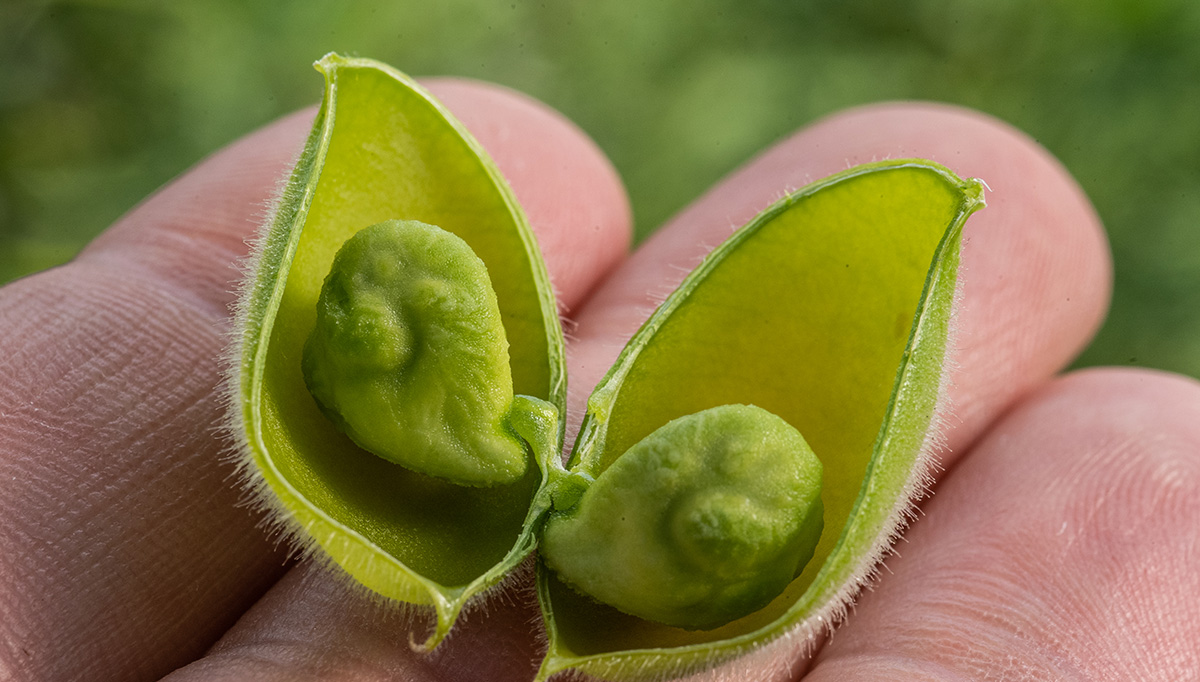
While their nitrogen contribution may not fully meet the needs of demanding crops like sunflower, chickpeas still add valuable nitrogen, support soil health, and, importantly, extend the time between pea plantings, helping to minimize disease pressures, as chickpeas and peas do not share all diseases. Furthermore, chickpeas hold high market value in Europe, making them an economically attractive choice that enhances the sustainability of our rotation.
Altogether, chickpeas strengthen both ecological balance and economic resilience in our system.
This phased approach allows us to evaluate and fine-tune each crop’s role, building a foundation for a highly resilient, nutrient-balanced five-year rotation. By carefully analyzing crop performance, nutrient dynamics, and interactions with diseases and weeds at each stage, we are systematically working toward a sustainable, gluten-free rotation that meets both ecological and market demands.
Based on our results so far, we believe a five-year crop rotation of peas, oats, flax, chickpeas, and sunflowers, combined with careful soil management practices, offers a robust foundation for achieving both long-term ecological and economic sustainability in our system.
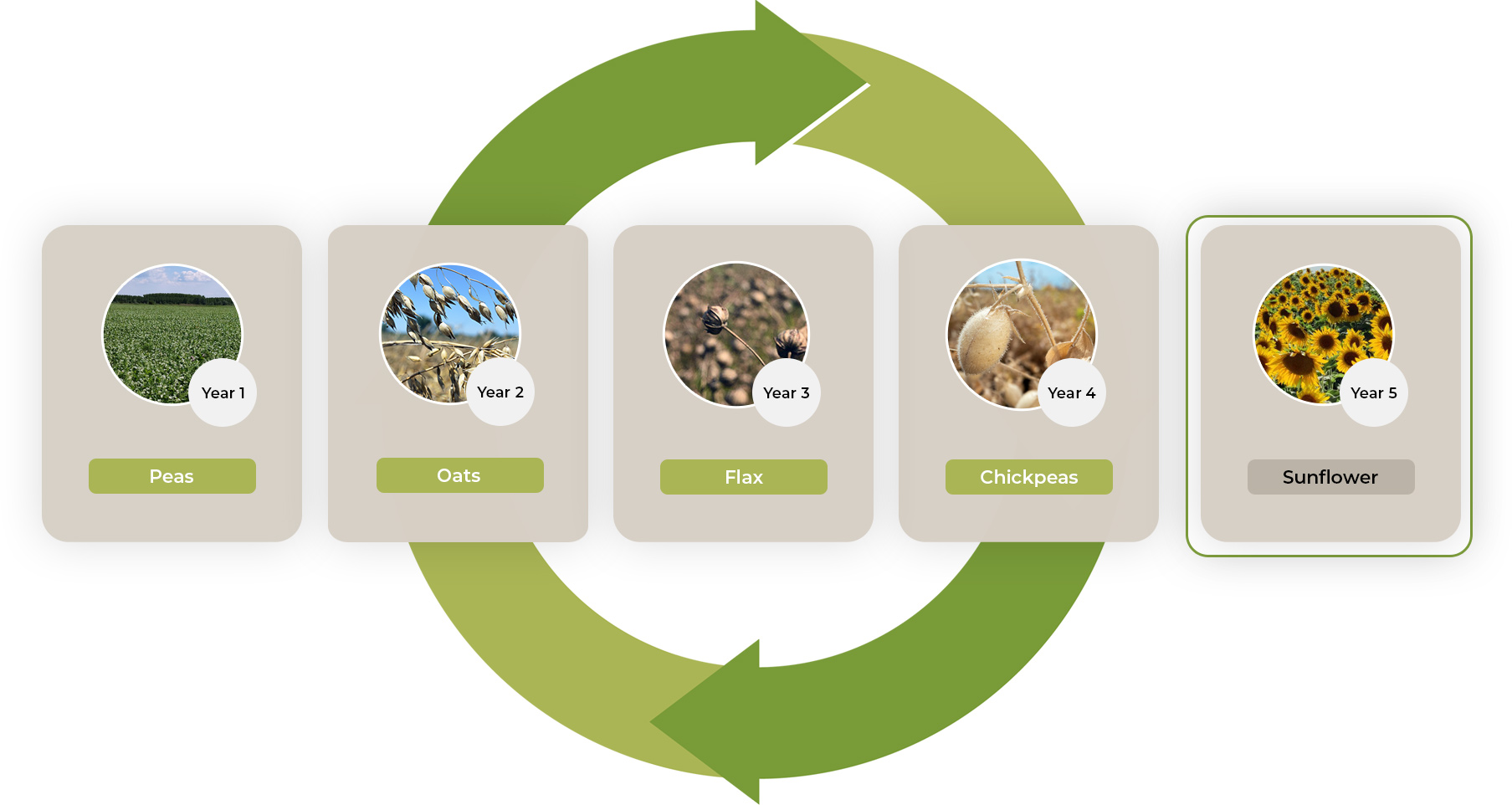
Each crop within this rotation serves a strategic role:
This rotation not only optimizes nitrogen balance, reducing the need for external inputs but also supports long-term soil health by diversifying root structures and nutrient uptake patterns. Through careful crop sequencing, we can mitigate disease pressures and improve resilience against pests, while maintaining high-value output. With this strategic five-year rotation, we aim to establish a self-sustaining, climate-resilient model that meets organic farming standards and delivers consistent economic returns.
Furthermore, this balanced crop rotation ensures that each year, 20% of our arable land is dedicated to one of these five crops, providing a predictable and efficient system for crop planning. This enables us to optimize our crop sales, plan the use of machinery effectively, and streamline labor management, ensuring a stable and profitable operation year after year.
Boom, I rest my case! This well-balanced five-year crop rotation is clearly the answer! Well, almost. Such a straightforward approach would work perfectly if our fields were uniform, with no variation in soil pH, texture, or weed pressure. However, that’s not the reality – and given that chickpeas, for example, are highly sensitive to pH levels below 5, have limited competitiveness against weeds, and oats are in high demand for health-conscious consumers – it’s clear that there isn’t a single, best fit crop rotation for all situations. Instead, we need a more nuanced strategy.
Starting in autumn 2025, we plan to develop and implement an asymmetrical crop rotation tailored to the varied conditions across our fields. This approach will feature carefully adjusted crop sequences, designed to align with specific soil pH, texture, and weed pressures, ensuring optimal performance and sustainability for each plot. This marks the beginning of a new chapter in our farming model—one we’re eager to refine and grow over the years ahead.
Crop rotation is fundamental to creating optimal conditions for sustainable food production. At LoginEKO, we began with a simple 3-year crop rotation and have progressively transitioned to modified 4-year rotations. We are now implementing a5-year crop rotation and working toward even more complex 6-year crop rotations to further enhance our sustainable farming model.
To contribute to the advancement of sustainable agriculture, we will regularly publish the results of our crop rotation strategies. By sharing insights and lessons learned, we aim to demonstrate the benefits of these approaches and inspire others to adopt practices that support ecological balance, long-term soil health, and productive farming systems.
Published in March 2024, updated December 13, 2024
Njamito is now Fairtrade certified for cocoa and vanilla! Here’s what that means for farmers, the planet, and the values behind our meal-in-a-bottle.
Read articleIdealism met reality as we launched our meal-in-a-bottle, Njamito. After 100.000 bottles sold, here’s what we learned about organic food and market adaptation.
Read articleWith organic seeds in short supply, we launched our own organic seed production journey to secure sustainable farming practices.
Read article